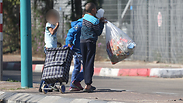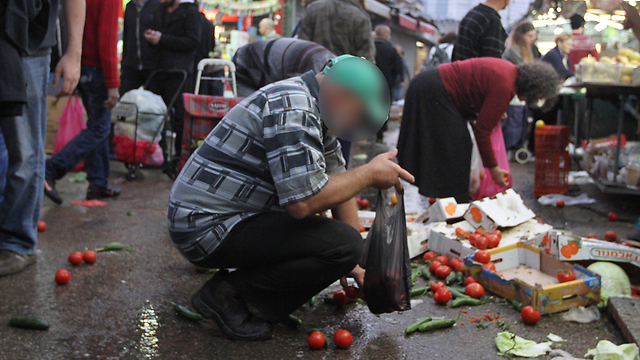
Alternative poverty report: Almost a third of Israelis are poor
According to figures collated by NGO Latet, 35% of Israeli children live in poverty while just under 30% of the entire population lack basic commodities or access to services required for a basic lifestyle.
The report is based on the relative shortage of essential goods required for the most basic lifestyle of every citizen.
The National Insurance Institution is expected to publish its official “Report of Poverty and Social Gaps,” which determines the number of people living in poverty in Israel, later this month.

According to Latet's index, which was compiled by private research company ERI and is published for a third year, 29% of the Israeli population, including both children and adults (2,436,000), live in poverty. If the figures are accurate, the alarming percentage equates to an adult poverty rate of 1.4 million—constituting a quarter of all adults.
The Latet report drew on information collected in a survey questioning 501 people from the general public along with another survey of 657 people supported by various assistance organization.
Despite the high figures, the new statistics indicate that poverty rates are on the decline when compared to the figures from the 2015 index, which showed that the number of children living in poverty stood at around 998,000 while the number of adults stood at 1.626 million. The overall figure, therefore, came out at 2.624 million.
Latet's alternative poverty index will be published during a conference on Monday at The Academic College of Tel Aviv-Yaffo and will illustrate five fundamental shortages required to lead a basic standard lifestyle: property, education, health, food security and the ability to meet the costs of living.
While poverty may have been marginally on the decline since 2015 according to Latet's report, when the latest report is compared with the official equivalent published by the National Insurance Institute last year for 2014, a stark deterioration of the situation can be discerned with the latter illustrating that 22% of Israeli citizens were recorded as living in poverty, amounting to 1,709,300 people, out of whom are 444,900 families and 776,500 children.
The statistics also suggest an exacerbation in the situation of the poorest people in the country, who receive succor from various aid groups. Indeed, 63% of those supported by such groups either work or are not at a working age but still remain impoverished nonetheless. The reported figure marks and increase of 11% when compared with the previous year.
The generally bleak outlook was encapsulated in the response provided by most of those questioned when asked what were the chances of falling into poverty, with 81% positing that a person can easily fall prey to its cruelty within just one year and that it can be caused simply by redundancy, an illness or a crisis.
Sixty-six percent of those receiving supportive aid were found to be in debt of some sort—almost double that of the general population (31.5%). Furthermore, the situation for children was no less grim with 54% of those supported by the groups were lacking basic learning stationery and required study material, signaling an 11% increase of children left wanting despite being supported.
Commenting on the findings, Latet Chairman Gilles Darmon and Director General Eran Weintrob said that “this is the third consecutive year that our poverty report shows that the poverty index is far higher than those published by the National Insurance Institute, which stretches the definition of the virtual 'poverty line' while relying only on the income parameter."
Darmon and Weintrob then accused the government of failing to shoulder the responsibility. “The government still refuses to take responsibility and is frightened of adopting conclusions of the committee to fight poverty.”
Minister of Welfare and Social Services Haim Katz's office responded to the criticism levelled against the government citing the marking of approximately NIS 224 million for food security.
“As part of the effort to eradicate the shameful phenomenon of queues for food, in the coming weeks we will provide a national food security project which will be given in its first stage to 10,400 families which will receive monthly cards of NIS 375 that can be used in supermarket chains at an annual cost of NIS 40 million,” the ministry’s office said in a statement.
“In general, we doubt the accuracy of the facts presented by (Latet) which are mainly intended for public relations purposes and to draw bigger financial contributions for the salaries of its leaders," the statement concluded.











